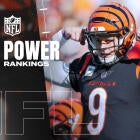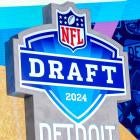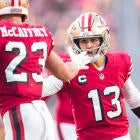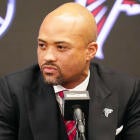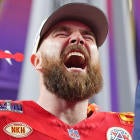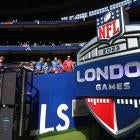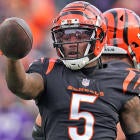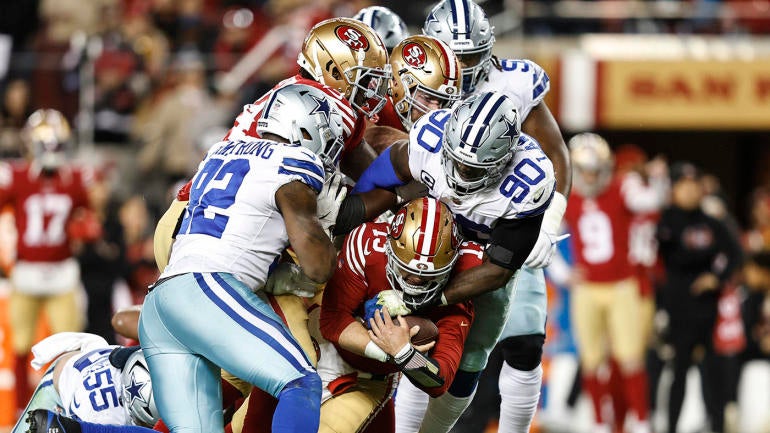
This Sunday night, there's a heavyweight NFL fight. For the third time in three seasons, the San Francisco 49ers and Dallas Cowboys are set to square off in a game with potentially massive implications. The first two of those battles came in the playoffs, with the Niners knocking the boys out of the postseason in the wild card round two years ago and the divisional round last year.
Entering this showdown, these two teams again look like two of the best in all of football; San Francisco is one of the league's two remaining 4-0 squads, while Dallas is 3-1 and leads the NFC in point differential (plus-83), sitting just one point behind Buffalo (plus-84) for the overall NFL lead. While much of the focus in advance of the game is understandably on the matchup between the Dallas offense and the San Francisco defense after the Niners shut down the Cowboys' attack in each of the prior bouts, the other side of the ball provides just as many interesting focal points.
Since Brock Purdy took over under center, the Niners have been perhaps the best offense in the NFL. They have scored 30 or more points in all but one of his regular-season starts, and they come into this game ranked second in the league in yards, third in points, second in FTN's DVOA (Defense-adjusted Valued Over Average), and second in TruMedia's version of EPA/play. In case you've been living under a rock, you should know that the Dallas defense has arguably been just as good: second in yards, first in points, first in DVOA, and second in EPA/play.
The Cowboys are absolutely terrorizing opposing offensive lines, generating pressure on an outrageous 55.6% of dropbacks, according to TruMedia. To put that in perspective, consider that the league average is a mere 35.5% and that the next-closest team to the Cowboys is the Green Bay Packers at 42.6%. The gap between Dallas and Green Bay (13%) is greater than the one between Green Bay and the Jacksonville Jaguars (30.2%) in 26th place.
Between Micah Parsons and Demarcus Lawrence, the Cowboys sport two of the most dominant edge rushers in the NFL, and Dan Quinn generates favorable one-on-one matchups for them with relative ease. They're supported by Dante Fowler Jr., Sam Williams, and Dorance Armstrong, each of whom ranks in the top third of the league in pressure rate among the 215 players who have rushed the passer at least 40 times so far this season. Throw in what both Osa Odighizuwa and Chauncey Golston have done from the interior (they have each generated pressure about as often on a per-rush basis as Cameron Jordan), and there are just so many ways for the Cowboys to wreck things up front.
The one relative weakness the San Francisco offense has shown so far this season has been on the right side of the offensive line, where Colton McKivitz gave up three sacks to T.J. Watt back in Week 1. That's where Lawrence typically rushes from, and given how he's played so far this season, that could prove to be a sizable mismatch. Quinn could move Lawrence around some, but he will definitely move Parsons around a whole lot, doing whatever he can to get Parsons enough space to win a one-on-one matchup, even on the interior. And he'll run twists and stunts all day long, hoping to confuse the more inexperienced (i.e. non-Trent Williams) members of San Francisco's offensive line.
Of course, if there is anyone who can scheme around offensive line issues, and do it while also taking advantage of the Dallas defense's aggressiveness, it's probably Kyle Shanahan. Despite the offensive line being a relative weakness for this time, Purdy has rarely been under pressure: he's been sacked, hit, or hurried on 36.4% of his dropbacks, a rate that is within 1% of the league average. That's because Purdy gets the ball out remarkably quickly thanks to his fast trigger and Shanahan's play design. His 2.46 seconds to throw average is fourth-lowest in the NFL. He just identifies where it's supposed to go and gets it there, post haste, and allows the diverse array of playmakers the Niners have assembled to do a lot of the heavy lifting. San Francisco has generated 453 receiving yards after the catch so far this season, a top-10 mark despite being the run-heaviest team in the league to date.
He'll need to maintain that quick trigger against Dallas, which generates pressure faster than just about every other team. According to TruMedia, the average quarterback has been under duress about 2.3 seconds after the snap against the Cowboys defense. That's just a hair before Purdy usually gets the ball out. How he manages that gap, and whether he can stay calm against the pressure bearing down against him, will play a massive role in how much aerial success San Francisco has on Sunday night. The game against the Cowboys in last year's playoffs was one of just two in his career so far where Purdy did not throw at least one touchdown pass, and it's the only one (except for the NFC title game against the Eagles when he left with a UCL injury) where he did not score at all. The Cowboys did have him off balance for a lot of that game.
If and when he gets time, it wouldn't be surprising if the Niners found success attacking their favorite area: the middle of the field. According to FTN, Dallas ranks first in DVOA against throws to the left side of the field and first against throws to the right. But it ranks 27th against throws over the middle. That's exactly where Shanahan and Co. want to attack, and it's where Purdy does his best work. On throws between the numbers (which account for exactly half of his attempts), he's 44 of 56 (78.6%) for 574 yards (10.3 YPA) and two touchdowns, and leads the NFL in EPA/play. The primary over-the-middle weapons in the short and intermediate areas of the field are Christian McCaffrey and George Kittle, but Shanahan has ways of designing things for Brandon Aiyuk and Deebo Samuel to find plenty of space there, too.
When the Cowboys drop back into coverage, they settle into either Cover-1 or Cover-3 (single-high safety defenses) more often than almost any other team in the league. Purdy is third in EPA/dropback against those coverages this year, per TruMedia, completing 44 of 58 passes (75.9%) for 539 yards (9.3 per attempt) and two touchdowns. He's been marginally less effective against two-high defenses like Cover-2 and Cover-4, but has still connected on 69.2% of his throws at an average of 9.1 yards per attempt. In other words, he has found success no matter what defenses have thrown at him so far.
But the Cowboys so far this season have held No. 1 wide receivers in check (seventh in DVOA), as well as No. 2s (fourth), tight ends (sixth) and running backs (first). They no longer have Trevon Diggs after he tore his ACL during a Week 3 practice, but this offseason's trade for Stephon Gilmore, the return of Jourdan Lewis, the continued ascension of DaRon Bland, and the three-headed safety monster of Jayron Kearse, Malik Hooker, and Donovan Wilson (not to mention Juanyeh Thomas and Markquese Bell) makes things incredible difficult for opponents on the back end. There are very few friendly places to attack. The best bet is probably targeting Leighton Vander Esch in coverage, but Dallas does a good job of figuring out ways to keep him doing the things he's best at rather than tasking him with difficult coverage assignments.
Still, the 49ers have plenty of ways to generate the matchups they want. Few teams send players in motion more often than San Francisco, which has done so on 69.4% of its snaps -- third-most in the NFL, per TruMedia. Dallas has faced motion fairly infrequently so far this season, with opponents using it on the third-fewest number of plays. The Cowboys have done well on those snaps, too, checking in fifth in EPA/play and scarcely allowing opponents to break explosives against them. That's what San Francisco does best, though, and it will be a far different challenge to keep this group in check than it has been to do the same to the teams the Cowboys have played thus far.
The Niners will also surely try to run the ball down Dallas' throat. The Cowboys have allowed opponents the highest yards-before-contact-per-carry average so far this season, per TruMedia, indicating that when you want to run it right at them, the Cowboys' defensive line is at least relatively beatable. The job they have done tackling (lowest missed tackle rate in the NFL) has limited the damage, as has the fact that they have stuffed opponent runs at or behind the line of scrimmage at the second-highest rate in the league. But when you do get a push against them, there is typically a lot of room to run. Whether the Niners can generate that push is the operative question. Their best opportunity to do so will probably come on plays where Parsons is lined up across from Trent Williams, due to the massive size advantage Williams holds.
Alas, you can only run it down Dallas' throat when you're in advantageous situations, which usually means you need to play from ahead and/or generate lots of short-yardage opportunities. Whenever the Cowboys front has gotten a chance to tee off with its pass rush, opponents have crumbled under the weight of all the problems that Quinn, Parsons, Lawrence, and the rest of them present. The only team to find any success against this defense so far this season is the Cardinals, who staked themselves to an early lead by scoring on their first two drives and then were able to play freely the rest of the way. For San Francisco to emulate that success -- and to fare better than it did in last year's playoff matchup, frankly -- it will likely have to do the same.














